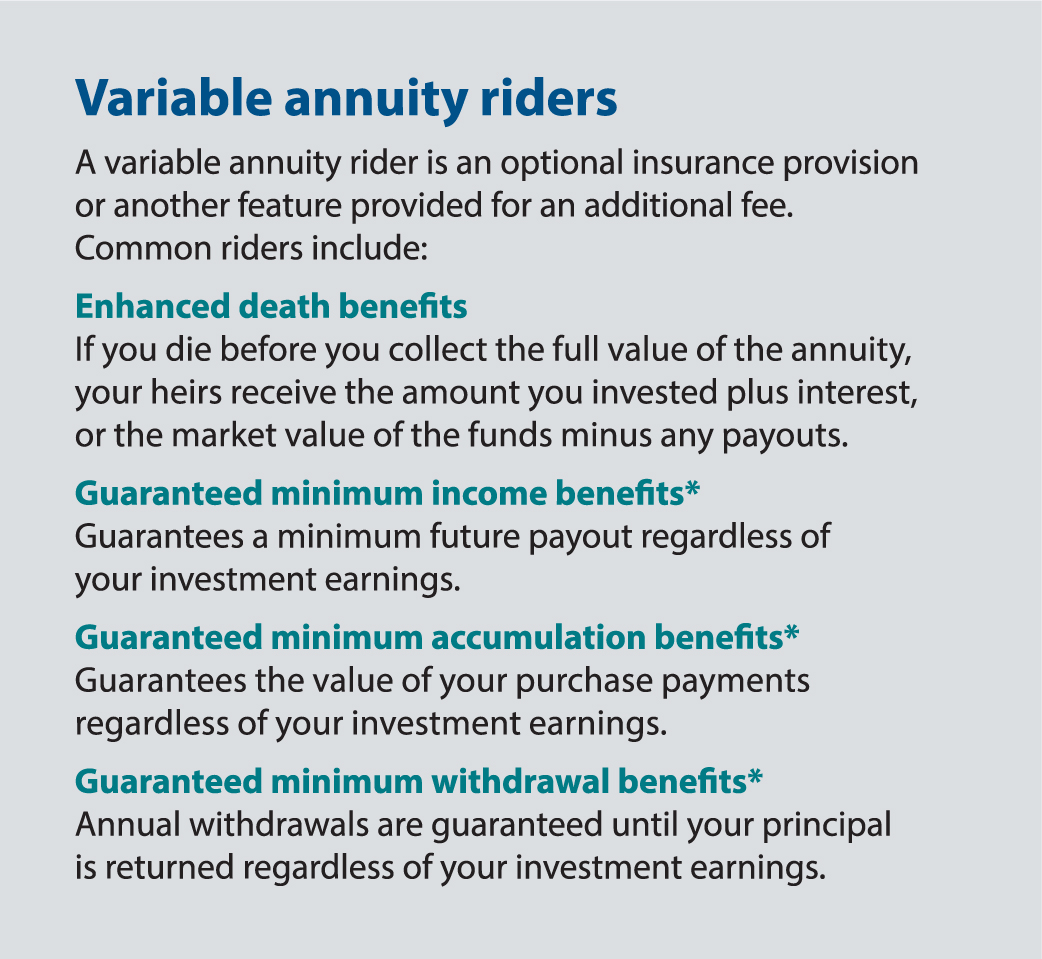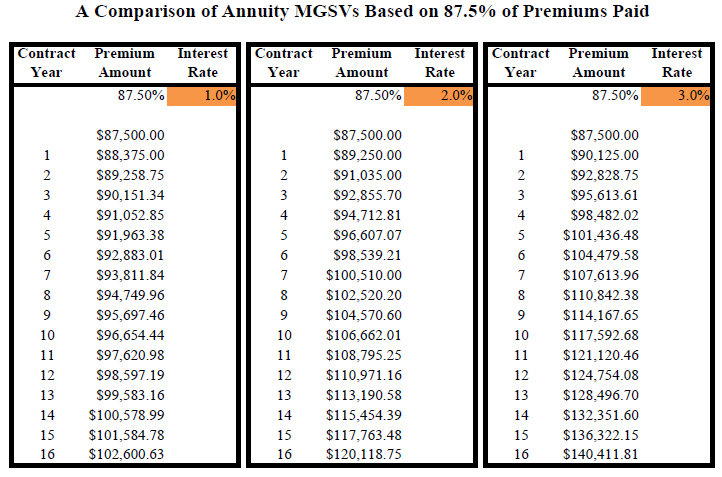All Categories
Featured
Table of Contents
Just as with a dealt with annuity, the owner of a variable annuity pays an insurance policy business a swelling amount or series of repayments in exchange for the assurance of a series of future payments in return. As discussed over, while a repaired annuity expands at an assured, consistent rate, a variable annuity expands at a variable price that depends upon the performance of the underlying financial investments, called sub-accounts.

Throughout the buildup phase, assets spent in variable annuity sub-accounts expand on a tax-deferred basis and are taxed just when the contract owner takes out those profits from the account. After the build-up phase comes the income stage. Over time, variable annuity assets ought to theoretically enhance in worth up until the agreement proprietor determines she or he would such as to start withdrawing money from the account.
The most considerable problem that variable annuities generally existing is high price. Variable annuities have a number of layers of charges and expenditures that can, in aggregate, create a drag of up to 3-4% of the agreement's worth every year. Below are the most typical fees connected with variable annuities. This cost compensates the insurer for the threat that it assumes under the regards to the agreement.
Highlighting the Key Features of Long-Term Investments A Closer Look at How Retirement Planning Works Defining the Right Financial Strategy Features of Fixed Annuity Vs Variable Annuity Why What Is A Variable Annuity Vs A Fixed Annuity Matters for Retirement Planning How to Compare Different Investment Plans: A Complete Overview Key Differences Between Different Financial Strategies Understanding the Risks of Long-Term Investments Who Should Consider Fixed Income Annuity Vs Variable Growth Annuity? Tips for Choosing the Best Investment Strategy FAQs About Immediate Fixed Annuity Vs Variable Annuity Common Mistakes to Avoid When Choosing Fixed Index Annuity Vs Variable Annuity Financial Planning Simplified: Understanding Variable Annuity Vs Fixed Annuity A Beginner’s Guide to Smart Investment Decisions A Closer Look at Fixed Income Annuity Vs Variable Growth Annuity
M&E expense costs are computed as a percent of the agreement value Annuity companies hand down recordkeeping and various other management costs to the agreement proprietor. This can be in the form of a level annual fee or a percentage of the contract worth. Management charges may be consisted of as part of the M&E threat charge or may be assessed individually.
These charges can range from 0.1% for passive funds to 1.5% or more for proactively managed funds. Annuity contracts can be customized in a number of methods to serve the certain requirements of the agreement owner. Some usual variable annuity cyclists consist of guaranteed minimal build-up benefit (GMAB), assured minimum withdrawal advantage (GMWB), and guaranteed minimum income benefit (GMIB).

Variable annuity payments offer no such tax obligation deduction. Variable annuities tend to be very ineffective vehicles for passing wealth to the future generation because they do not delight in a cost-basis modification when the original contract owner dies. When the owner of a taxed investment account passes away, the cost bases of the financial investments held in the account are gotten used to show the marketplace costs of those financial investments at the time of the owner's fatality.
Exploring the Basics of Retirement Options Everything You Need to Know About Choosing Between Fixed Annuity And Variable Annuity What Is the Best Retirement Option? Pros and Cons of Various Financial Options Why Fixed Annuity Or Variable Annuity Is a Smart Choice Fixed Indexed Annuity Vs Market-variable Annuity: Simplified Key Differences Between Different Financial Strategies Understanding the Rewards of Annuity Fixed Vs Variable Who Should Consider Tax Benefits Of Fixed Vs Variable Annuities? Tips for Choosing the Best Investment Strategy FAQs About Planning Your Financial Future Common Mistakes to Avoid When Planning Your Retirement Financial Planning Simplified: Understanding Your Options A Beginner’s Guide to Smart Investment Decisions A Closer Look at Annuity Fixed Vs Variable
For that reason, heirs can inherit a taxed investment portfolio with a "fresh start" from a tax point of view. Such is not the case with variable annuities. Investments held within a variable annuity do not obtain a cost-basis change when the original owner of the annuity passes away. This suggests that any accumulated unrealized gains will certainly be handed down to the annuity proprietor's heirs, in addition to the connected tax obligation worry.
One substantial concern connected to variable annuities is the capacity for conflicts of interest that might feed on the part of annuity salesmen. Unlike an economic advisor, who has a fiduciary obligation to make financial investment decisions that profit the customer, an insurance policy broker has no such fiduciary responsibility. Annuity sales are highly rewarding for the insurance policy professionals that sell them as a result of high ahead of time sales compensations.

Many variable annuity agreements have language which places a cap on the portion of gain that can be experienced by specific sub-accounts. These caps protect against the annuity proprietor from completely getting involved in a section of gains that might otherwise be enjoyed in years in which markets produce significant returns. From an outsider's viewpoint, it would certainly seem that capitalists are trading a cap on investment returns for the aforementioned guaranteed floor on investment returns.
As noted over, give up charges can drastically limit an annuity proprietor's capability to move properties out of an annuity in the early years of the contract. Even more, while the majority of variable annuities permit agreement proprietors to take out a defined amount throughout the build-up stage, withdrawals past this amount commonly cause a company-imposed fee.
Withdrawals made from a fixed rate of interest investment alternative can additionally experience a "market price change" or MVA. An MVA adjusts the value of the withdrawal to mirror any kind of adjustments in passion rates from the time that the cash was spent in the fixed-rate alternative to the time that it was withdrawn.

Frequently, even the salesmen that sell them do not completely understand how they function, therefore salesmen sometimes take advantage of a buyer's emotions to offer variable annuities rather than the values and suitability of the products themselves. Our company believe that investors must completely comprehend what they have and just how much they are paying to possess it.
Understanding Fixed Annuity Vs Variable Annuity A Closer Look at Annuities Variable Vs Fixed What Is Variable Annuity Vs Fixed Indexed Annuity? Advantages and Disadvantages of Different Retirement Plans Why Choosing the Right Financial Strategy Can Impact Your Future Fixed Index Annuity Vs Variable Annuities: Simplified Key Differences Between What Is A Variable Annuity Vs A Fixed Annuity Understanding the Risks of Long-Term Investments Who Should Consider Strategic Financial Planning? Tips for Choosing the Best Investment Strategy FAQs About Variable Annuity Vs Fixed Indexed Annuity Common Mistakes to Avoid When Choosing Deferred Annuity Vs Variable Annuity Financial Planning Simplified: Understanding Annuities Variable Vs Fixed A Beginner’s Guide to What Is Variable Annuity Vs Fixed Annuity A Closer Look at How to Build a Retirement Plan
Nonetheless, the very same can not be stated for variable annuity assets held in fixed-rate investments. These possessions legally come from the insurance policy firm and would therefore be at threat if the firm were to fail. Any type of guarantees that the insurance coverage company has agreed to offer, such as an ensured minimal revenue benefit, would be in question in the event of a service failure.
Prospective purchasers of variable annuities should recognize and consider the economic problem of the providing insurance company before getting in right into an annuity contract. While the benefits and drawbacks of various types of annuities can be disputed, the genuine problem bordering annuities is that of suitability.
As the saying goes: "Customer beware!" This article is prepared by Pekin Hardy Strauss, Inc. Fixed annuities vs market risk. ("Pekin Hardy," dba Pekin Hardy Strauss Wealth Management) for educational functions just and is not planned as a deal or solicitation for service. The info and data in this article does not constitute lawful, tax obligation, bookkeeping, financial investment, or various other specialist recommendations
Table of Contents
Latest Posts
Decoding Fixed Interest Annuity Vs Variable Investment Annuity A Closer Look at How Retirement Planning Works Defining Retirement Income Fixed Vs Variable Annuity Benefits of Choosing the Right Financ
Breaking Down Your Investment Choices A Closer Look at How Retirement Planning Works Defining the Right Financial Strategy Pros and Cons of Fixed Vs Variable Annuities Why Variable Vs Fixed Annuity Is
Decoding How Investment Plans Work Key Insights on Your Financial Future What Is Fixed Vs Variable Annuity? Pros and Cons of Various Financial Options Why Choosing the Right Financial Strategy Is Wort
More
Latest Posts